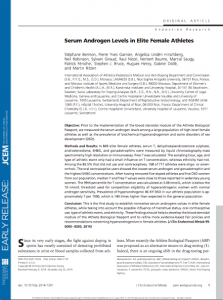No scientific basis for current policy excluding elite intersex women from sport

The Journal of Clinical Endocrinology and Metabolism this month contains a report on research by the International Association of Athletics Federations’ Medical and Anti-Doping Department and Commission, and others. It states that there is “no clear scientific evidence” for current policies excluding elite intersex women athletes from competitive sport on the basis of high androgen levels:
With the exception of data extracted from doping programs in female athletes in the former German Democratic Republic (7), there is no clear scientific evidence proving that a high level of T [testosterone] is a significant determinant of performance in female sports.
Further, the current policy is based upon an arbitrary definition:
A hot point of discussion here concerned an independent expert medical panel recommending that the athlete is not eligible to compete in women’s competition if she has normal androgen sensitivity and serum T levels above the lower normal male range (10 nmol/L). This arbitrary definition was chosen in the absence of normative statistics of androgen levels in a high-level athlete female population.
The study examined the hormone profiles of 849 elite women athletes who provided blood samples in order to comply with antidoping regulations. For athletes with intersex variations, receipt of test results may well be the moment when they first discover their intersex status.
The report undermines the case for current policies excluding elite women athletes with “hyperandrogenism” from competitive sport. A woman athlete with high androgen levels was excluded from the Commonwealth Games this year in Glasgow. The British Medical Journal reported this April how four elite intersex women athletes were subjected to sterilisation and “partial clitoridectomy” (FGM) in order to continue to compete.
The unnecessary and coercive context for “partial clitoridectomy” and sterilisation is of enormous concern. It forms part of a broader focus on athletes’ physical characteristics and perceived femininity or masculinity:
On the basis of clinical features (masculine body build, hirsutism, abnormal external genitalia observed during the antidoping procedures, secondary investigations performed in specialized centers), urinary test results (urinary steroid profiles, T to EpiT ratio, screening for banned anabolic doping agents, isotope ratio mass spectrometry to detect illicit T use), and hormonal blood results obtained from antidoping campaigns, it was possible to suspect and confirm 10 cases of doping and/or DSD [intersex traits] among the female population studied.
Research on what constitutes “normal” women’s genitalia shows it to be subjective; a recent Senate inquiry found this research “disturbing“.
The research also notes the higher population figures for intersex traits amongst the 849 women (similar data is curiously not available for men):
Within the female population studied, six subjects (five plus one who was previously declared eligible to compete) were later identified with a hyperandrogenic 46 XY DSD (four with 5alpha-reductase deficiency and two with partial androgen insensitivity). Thus, the calculated prevalence of this type of medical condition within this cohort of high-level female athlete is 7.1 per 1000. Because, in this study, screening for SRY was not performed (we looked only for women that were hyperandrogenic), it is possible that the actual prevalence of 46 XY was even higher. Morel et al (33) estimated a 46 XY DSD occurrence rate of 1 in 20 000 in the general population. Although the occurrence may change from one ethnic group to another, our reported prevalence remains approximately 140 times higher than expected in the general population.
As an aside, we note that XY 5alpha-reductase deficiency, present in four cases, and AIS present in two, are both regarded in the UK as “sufficiently serious” traits meriting de-selection from the gene pool via IVF. In our view, the only reasons for this are related to perceptions of sex non-conformity and poorly-evidenced, perceived needs for surgical and/or hormonal “correction”.
Finally, claims of perceived masculinity and performance advantages are by no means unique to elite intersex women athletes; these issues are also faced by trans women, and also women with PCOS. The research acknowledged that PCOS (not an intersex variation) is also common amongst elite women athletes:
Although the present study was not designed to diagnose polycystic ovary syndrome (PCOS), one may suspect, as previously reported by Hagmar et al (22), that several of our athletes experienced this medical condition… Hagmar et al (22) reported an overrepresentation of polycystic ovaries in female Olympic athletes (37% vs 20% in the general population).
It is time to discontinue arbitrary and unscientific policies designed, in our view, to reinforce heteronormative and sexist notions of femininity in sport.
More information
- Full text PDF: Stéphane Bermon, Pierre Yves Garnier, Angelica Lindén Hirschberg, Neil Robinson, Sylvain Giraud, Raul Nicoli, Norbert Baume, Martial Saugy, Patrick Fénichel, Stephen J. Bruce, Hugues Henry, Gabriel Dollé, and Martin Ritzen (August 2014) Serum Androgen Levels in Elite Female Athletes, in Journal of Clinical Endocrinology and Metabolism, doi: 10.1210/jc.2014-1391
- HTML Abstract: Stéphane Bermon, Pierre Yves Garnier, Angelica Lindén Hirschberg, Neil Robinson, Sylvain Giraud, Raul Nicoli, Norbert Baume, Martial Saugy, Patrick Fénichel, Stephen J. Bruce, Hugues Henry, Gabriel Dollé, and Martin Ritzen (August 2014) Serum Androgen Levels in Elite Female Athletes, in Journal of Clinical Endocrinology and Metabolism, doi: 10.1210/jc.2014-1391
- OII Australia (25 July 2014) Let Dutee Chand run
- OII Australia (28 April 2014) Women athletes forced to undergo clitorectomies to compete
- OII Australia (October 2013) Statement on Australian Senate: Report on the involuntary or coerced sterilisation of intersex people in Australia
- OII Australia (28 January 2012) Medical research: No (wo)man is an island and subjective perceptions of genital normality
- Human Fertilisation & Embryology Authority (UK) (22 August 2014) PGD conditions licensed by the HFEA
You must be logged in to post a comment.